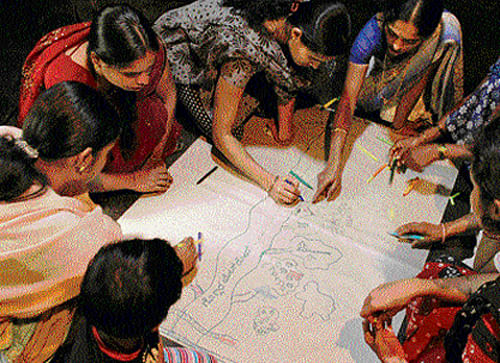
Narasimha Hegde writes about how people from different backgrounds and communities are coming together to save and sow certain kinds of fruit species in a village in Sirsi.
“For the first time, women in our village from different ethnic groups decided to form a women’s group called Matrabhoomi (mothers’ land) and started producing kokum juice concentrate. This with great success, as the first batch of 350 litres was well received by shopkeepers as a natural product of high quality.
Throughout the process we learnt a lot about various Native Fruit Trees (NFTs) available in our village and surrounding forests, their abundance, threat status and to some extent how to manage them sustainably” said Mrs Nagaveni, leader of the women’s group from Kalgadde Kanchigadde village.
The village is located in the remote forest area of the central Western Ghats, where more than 75 per cent of the land is under forest cover. Farming, agricultural labouring and gathering of forest resources are the primary livelihood activities of villagers. Many marginalised socio-religious and tribal communities, including Siddis and Khare Vokkaligas, live below the poverty line.
Identifying gendered knowledge differences from different socio-religious and cultural groups, providing exposure on value chains and product development for NFTs were critical steps that led to positive changes in livelihoods, gender equality and social inclusion, and forest genetic resource management. For the research participants were separated into four groups according to gender and age and there were 8 to 10 participants in each group. Each group conducted the same activities and presented its findings to all participants to stimulate discussion across groups.
Resource mapping
Resource mapping consisted of villagers drawing the map of their landscape to understand the village setting, identify and locate local NFTs, their availability, usage and management. Four Cell Analysis was used to understand the diversity; degree of occurrence of NFTs as common, unique or rare in the village and surrounding forests.
Fruit Calendars further helped to understand the phenology (flowering and fruiting behaviour) of specific tree species, whereas activity calendars revealed information on the different tasks, knowledge and skills related to the propagation, collection or cultivation, harvesting, processing, home use and sale of NFTs and their products.
A participatory Theatre play entitled ‘The blue square mango’, involved actors from the community, and was carried out during a village assembly to help the villagers understand the concepts and different interests of actors involved in a value chain. Community members then conducted Participatory Value Chain Mapping (PVCM) to understand and identify gendered knowledge and market constraints, and Participatory Rapid Market Appraisal (PRMA) was done to collect market information from traders or retailers and provide exposure to women participants regarding quality requirements, value addition, packaging and marketing aspects of selected NFTs. Finally, those women developed a second participatory value chain map to populate it with the new knowledge they had gained through the PRMA.
Women of all ages and diverse socio-cultural groups felt that their knowledge about NFTs and markets for their products had increased throughout the research process. Women shared specific knowledge about NFT recipes, medicinal uses, and nutritional values and processing techniques, which the men’s groups did not have, and the men’s groups appreciated women for having expertise in these areas. Several of those women spoke for the first time in front of a mixed-gender group, especially the illiterate women who constituted the majority of the participants. Collective learning related to NFT diversity and processing activities increased the local knowledge, built social capital, and boosted women’s confidence.
Parvati, a woman from the Siddi community says, “Now that we learned about all the species that are under threat, it is our responsibility to conserve these NFTs by adopting sustainable harvest and usage practices and by cultivating them.” The research process lasted only 12 months with about 10 days of coordinated meetings or activities. PVCM and PRMA activities encouraged local women to start preparation of various products from Garcinia, among other NFTs.
“In our village, people of different age groups, genders and castes are now gathered here to discuss issues related to NFTs; we will supply the raw fruits to the recently formed women’s group as we know climbing trees and harvesting practices, and other members will do the processing, value addition and marketing,” says Mrs Yenki, also from the Siddi community.
The remoteness of the villages, illiteracy, difficult socio-economic conditions, lack of skills in processing, packaging, labelling and market access were some of the critical challenges in promoting the conservation and use of NFTs. Yet, a clear goal, the strategy of engaging the diversity of participants in the research process and having them come together to share knowledge, their own persistence to collaborate and the experience of the facilitators working with local communities for the past 20 years in the region contributed to the success of the project, which has been replicated in two other villages with hopefully many more to come.
Apart from value addition and marketing, now the villagers have started to think of implementing the sustainable harvesting measures for the threatened species. Domestication and cultivation of NFTs have been started in the village.
(Hugo A H Lamers and Marlene Eliasof Bioversity International also contributed to the story)